FiiO M11 Pro Digital Audio Player Review

FiiO M11 Pro Digital Audio Player Review
Introduction:
The FiiO M11 Pro is a member of the M Series Portable Digital Audio Player (in short DAP) together with models like the M5, M6, M7, M9 and M11.
The FiiO M11 Pro is the latest Digital Audio Player of the company and features some nice hardware specs like dual AK4497EQ DAC’s, 5.15” 720P resolution touch screen, both 2.5mm & 4.4mm Balanced outs, Samsung Exyons 7872 SoC, Two-way Bluetooth Transmission with LDAC support and many more.
Official Webpage: https://fiio.com/m11pro

Disclaimer:
I would like to thank FiiO for providing me the M11 Pro as review sample. I am not affiliated with FiiO beyond this review and these words reflect my true and unaltered, opinions about the product.
Purchase Links:
The FiiO M11 Pro is available for under the following purchase links;
Package and Accessories:
The FiiO M11 Pro came in a black box with FiiO branding on the top which was wrapped with a cardboard that features the illustration of the M11 Pro and some brandings on the top and technical details at the back of it.

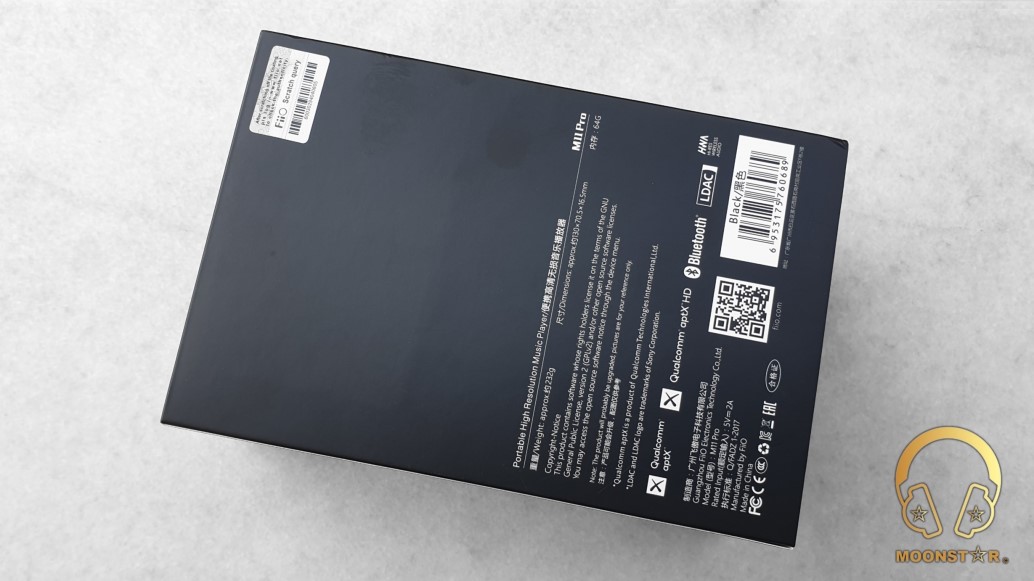
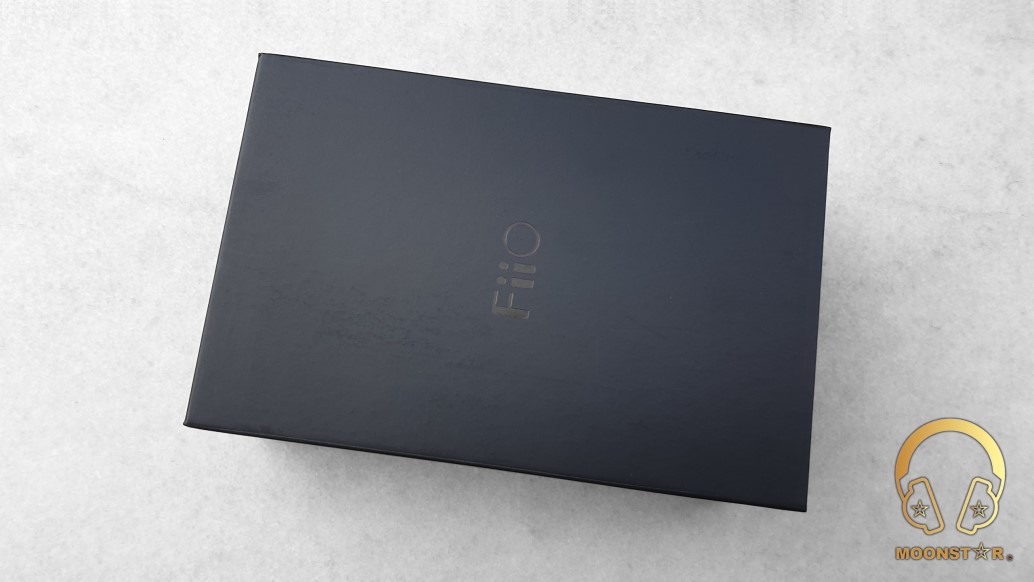
This box is containing the following items/accessories;
- 1 x FiiO M11 Pro Digital Audio Player
- 1 x USB Type-C Charging/Data Cable
- 1 x Coaxial Cable
- 1 x Micro SD Card Slot Removing Tool
- 1 x Quick Start Guide
- 1 x Warranty Card


A positive point in terms of protection is that that the M11 Pro came with a pre-installed screen protector which is made of glass and fits nicely to the gorgeous screen of the device.
Please not that there is no protective case included to the package that was usually a standard accessories of all previous FiiO DAP products, which means you need to purchase one separately like in the picture below.
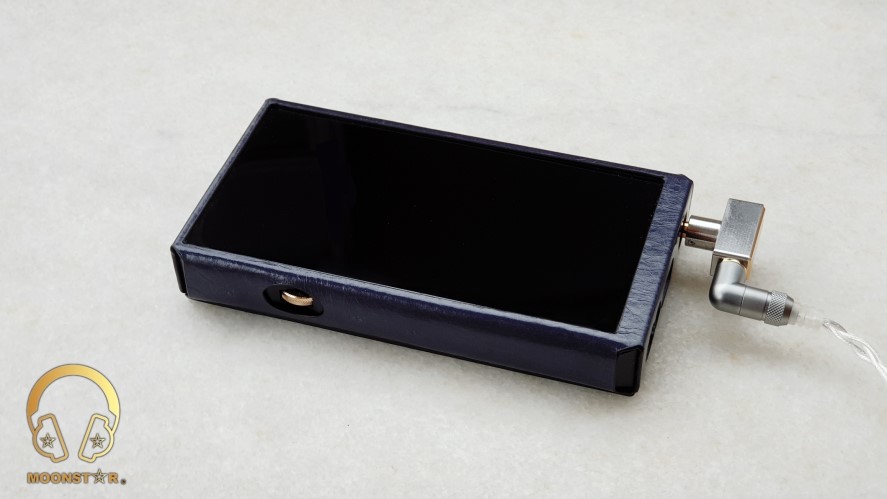

Design, Buttons and Build Quality:
The FiiO M11 Pro has polygonal style design language with a massive screen on the top.
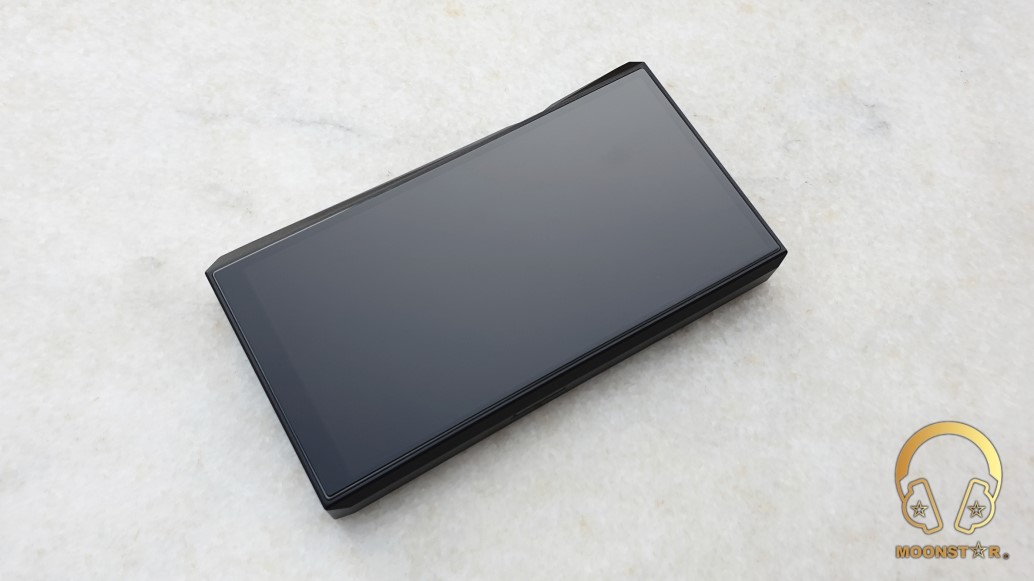
It is definitely bigger compared to previous M series DAP’s with a dimension of about 130×70.5×16.5mm and weights approx 232 grams. It feels very solid in your hands but is a bit slippery due to the glass surface on the back, which is why I highly advice you to get a Protective Case for it.
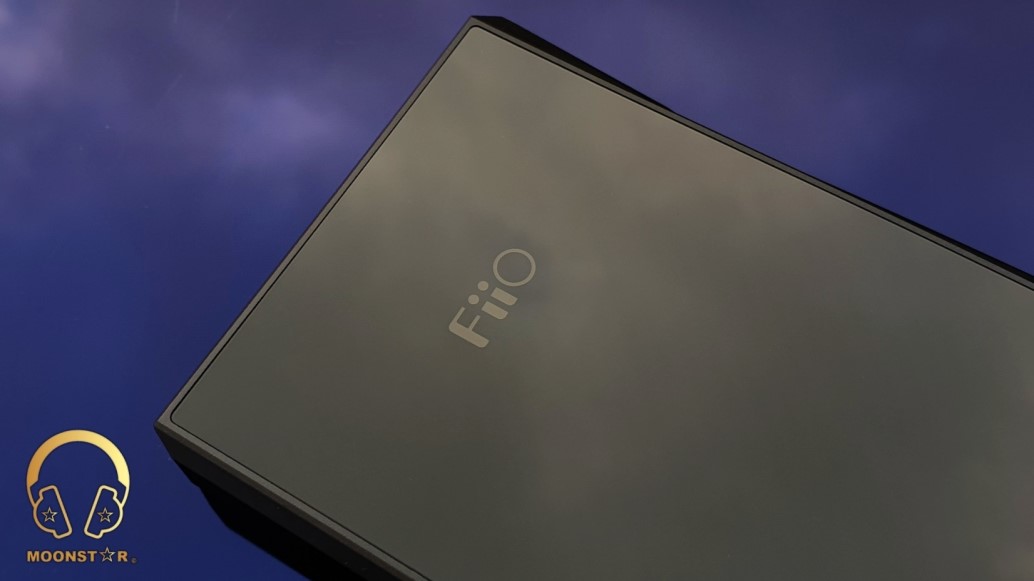
On the front of the device is the 5.15’’ 720P (1440×720) IPS touch screen with a pixel density (PPI) of 312PPI. The screen of the M11 Pro has a very nice screen to body ratio of approx 90%. It is maybe not as vivid and colorful like AMOLED/OLED panels on modern Smartphone’s but looks good anyway.

The pre-installed screen protector that is made of glass has nice 2.5D curves.
At the back side of the device is the surface with a Carbon Fiber pattern which has a massive glass on the top. The glass surface on the back (as well as on the front) features an oleophobic anti finger print layer and a special PET coating technology.
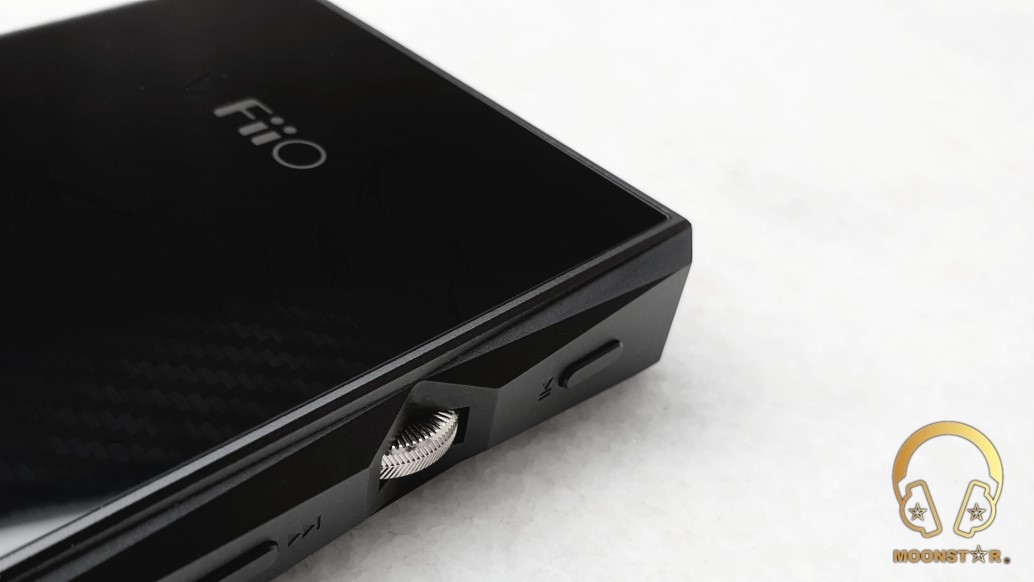
Here are also the FiiO brand logo, some industrial certificates (CE, FCC, etc.) and the THX, Hi-Res Audio/Wireless brandings.

On the top of the device is the power button with a LED indicator.

At the bottom of the chassis are the 4.4mm TRRRS Pentaconn Balanced out, the 2.5mm TRRS Balanced out, the USB Type-C connector that acts as Digital Out/Data/Charging Port and the 3.5mm headphone jack which shares the Phone Out, Line Out and SPDIF outputs.
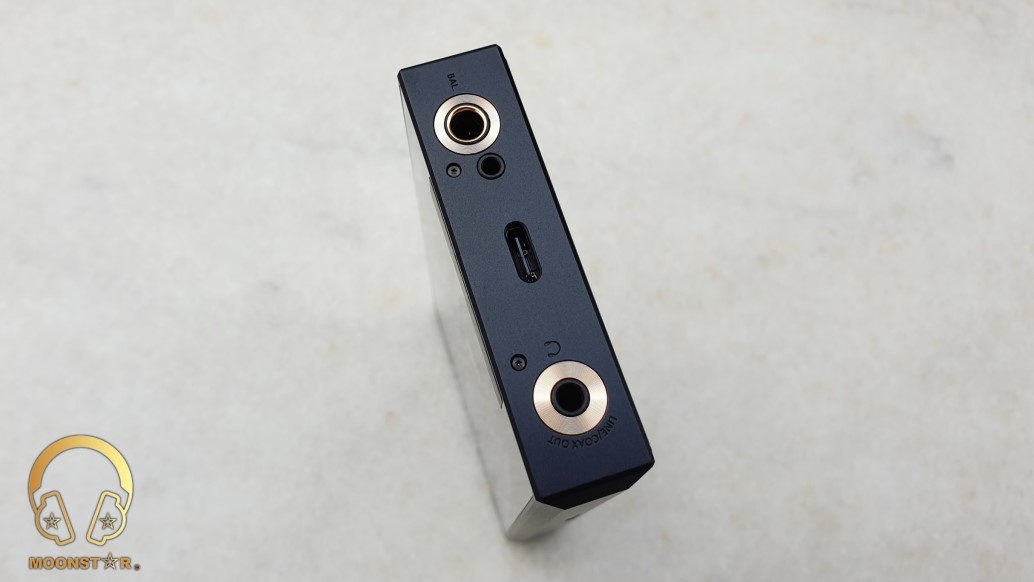
On the left surface is the play/pause button, the volume control wheel and the physical next/fast forward & previous/rewind button and the volume wheel that shows a quite precise and nice feedback.
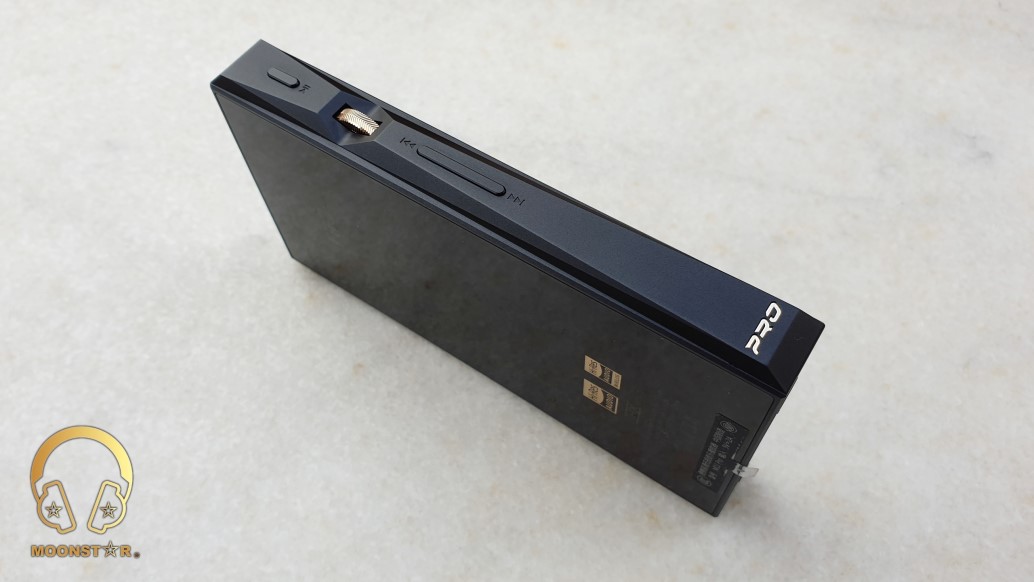
Here is also the “PRO” Logo which is made of gold plated nickel that has a nice appearance.

At the left size is a single micro SD card slot for storage expansion that supports
storage cards with theoretically up to 2TB.
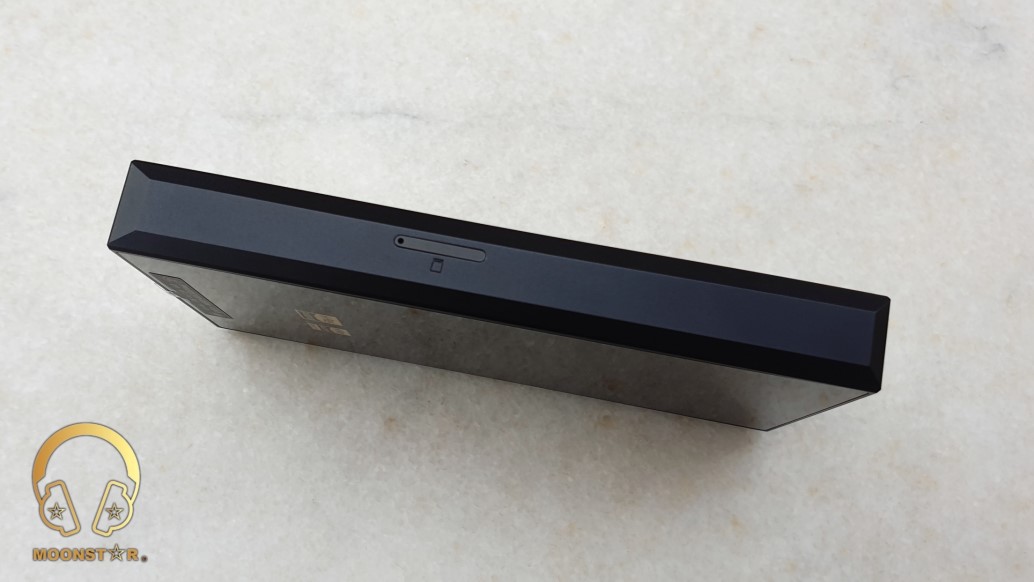
The main frame/chassis of the FiiO M11 Pro is made of metal and has a black painting. The device looks very robust any doesn’t show any imperfections like gaps, burrs or any openness, etc.

Some Technical Specifications:
- Operating System : Android 7.0
- CPU Model : Exynos 7872 14nm (with 6 Cores)
- DAC : AK4497EQ×2 (2x = dual)
- FPGA : A3P030
- Low Pass Filter (LPF) : OPA1642×3
- AMP : LMH6644*2
- Volume IC : NJW1195
- RAM : 3GB
- ROM : 64GB (52GB free 12GB reserved)
- Screen : 5.15” 1440*720 (720P) IPS Panel
- Analog Outputs : 3.5mm Output for LO, PO & SPDIF, 2.5mm & 4.4mm Balanced Out
- Digital Out : USB Type-C
- Wi-Fi : 2.4Ghz & 5Ghz
- Bluetooth chip : SAMSUNG S5N5C10B01-6330
- Bluetooth Two-Way : Transmitter HWA/LDAC/aptX HD/aptX/SBC & Receiver: SBC/LDAC
- Battery : 4370mAh 3.8V Li-polymer battery supporting quick charge
- Battery Life : up to 9.5 hours Single-Ended (Low Gain, Volume 63, Screen Off)
- Dimensions : 70.5mm x 130mm x 16.5mm
- Weight : about 232g
Supported Audio Formats:
The FiiO M11 Pro supports almost any traditional and modern audio format including MQA. The list of supported formats is as follows;
MQA, APE, FLAC, WAV, WMA, AAC, ALAC, AIFF, OGG, MP3, DFF, DSF, DXD, CUE, ISO, M3U, M3U8, MQA Native DSD: DSD64/128/256
1. Hardware:
The FiiO M11 Pro is a Portable Digital Audio Player that offers some nice hardware specs and noticeable improvements compared to past devices of the X and M series.
A) DAC (Digital to Analog Converter):
The AK4497 is a new generation Premium 32-bit 2 channel DAC with VELVET SOUND™ technology with low level distortion characteristics and wide dynamic range. The AK4497 integrates a newly developed switched capacitor filter “OSR Doubler”, making it capable of supporting wide range signals and achieving low out-of-band noise while realizing low power consumption. Moreover, the AK4497 has six types of 32-bit digital filters, realizing simple and flexible sound tuning in wide range of applications. The AK4497 accepts up to 768kHz PCM data and 22.4MHz DSD data which makes it ideal for the use of high-resolution audio sources like the FiiO M11 Pro.
Source: https://www.akm.com/global/en/products/audio/audio-dac/ak4497eq/
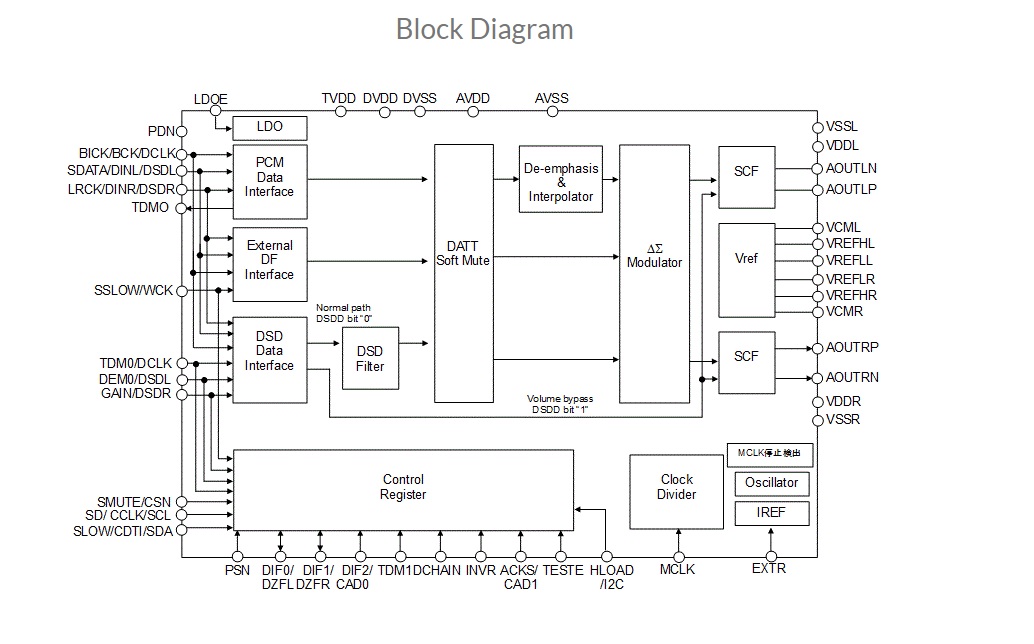
B) USB DAC:
The FiiO M11 Pro can be used as USB DAC with MAC’s, Windows PC’s, Android and iOS devices. Windows PC’s do need the installation of an USB DAC driver that is available on FiiO’s website, while Android, iOS and MAC computers do not need any driver installation.
Download link: https://www.fiio.com/Driver_Download
The USB DAC mode of the M11 Pro supports PCM32bit/384khz and native DSD up to x128
C) CPU/RAM/ROM:
The FiiO M11 Pro features an Exynos 7872 CPU of the company Samsung with 6 Cores. The 2 x A73 Cores are clocked @ 2GHz, while the 4 x A53 cores have a clock speed of 1.6GHz.
The Exynos 7872 that should be comparable to the Snapdragon 625 and Kirin 659 according to FiiO specs offers enough processing power for fairly fluid user experience.
The M11 Pro has 3GB’s of LPDDR3 type RAM and 64GB of ROM. The 12GB of the internal storage are reserved for the Operating System (OS) while 52GB’s are free to store your music files or for the installation of third party applications.
You can also expand the storage capacity via MicroSD cards with a capacity up to 2TB.
D) Wireless Connectivity:
The FiiO M11 Pro has a build in Wi-Fi antenna which supports the 802.11 b/g/n/ac protocols and 2.4GHz and 5 GHz frequency standards.
The download speed, connectivity range and stability is the best I have experienced to date with a Digital Audio Player and performs pretty close to modern mobile phones.
The M11 Pro has also a build-in Bluetooth chip of the company SAMSUNG with the model number S5N5C10B01-6330 that supports two-way Bluetooth audio transmission. The Bluetooth Chip of the M11 Pro is able to transmit HWA/LDAC/aptX HD/aptX/SBC codec’s and to receive codec’s in SBC/LDAC quality.
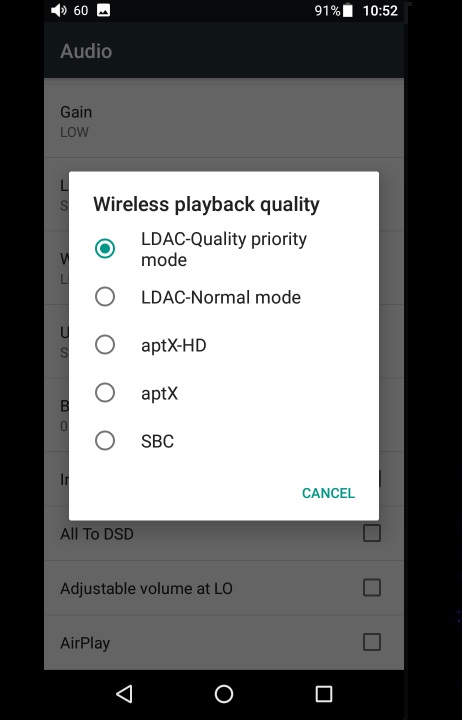
The stabile operating distance is approx 10 meters while the latency was very low to none when I have watched YouTube videos that I have transmitted from my Samsung Galaxy S9 Plus phone to the M11 Pro for test the performance.
Please note that I didn’t have heard any waterfall noise issue that could be caused by the Wi-Fi antenna and any remarkable Bluetooth connection droppings with my sample during this review.

DLNA/AirPlay/Wi-Fi file transfer:
The FiiO M11 Pro is able to play your songs stored on PC or NAS wirelessly through DLNA, or via AirPlay with iOS devices. You can also transfer your songs wirelessly to the M11 Pro by using the Wi-Fi transfer function which is a nice addition.

Output & Amplification:
The FiiO M11 Pro has a wide variety of output options that are located at the bottom of the device as I have mentioned before, which are the 4.4mm TRRRS Pentaconn Balanced out, the 2.5mm TRRS Balanced out, the USB Type-C connector that acts as Digital Out/Data/Charging Port and the 3.5mm headphone jack which shares the Phone Out, Line Out and SPDIF outputs.
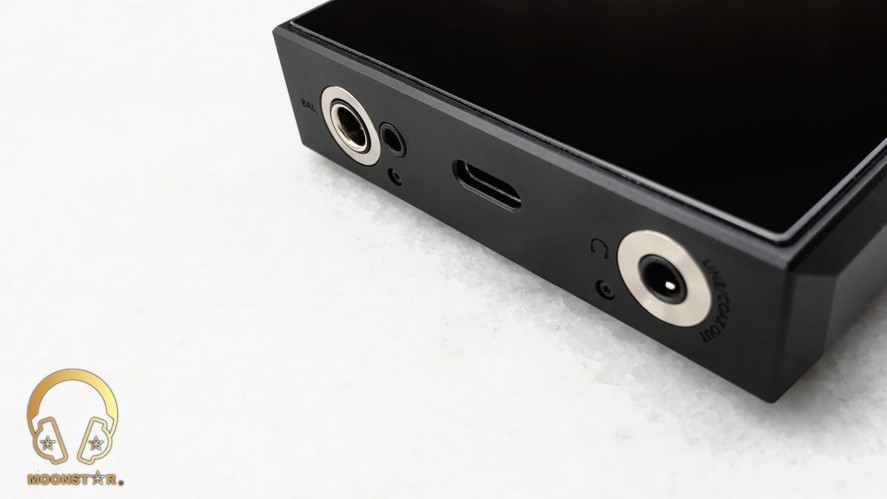
The FiiO M11 Pro has two so called fully balanced THX AAA 78 Amplifier with 8 Stage amplification. The amplifier section of the M11 Pro features 3 x OPA1642 Low Pass Filters and 2 x H6644 AMP’s.
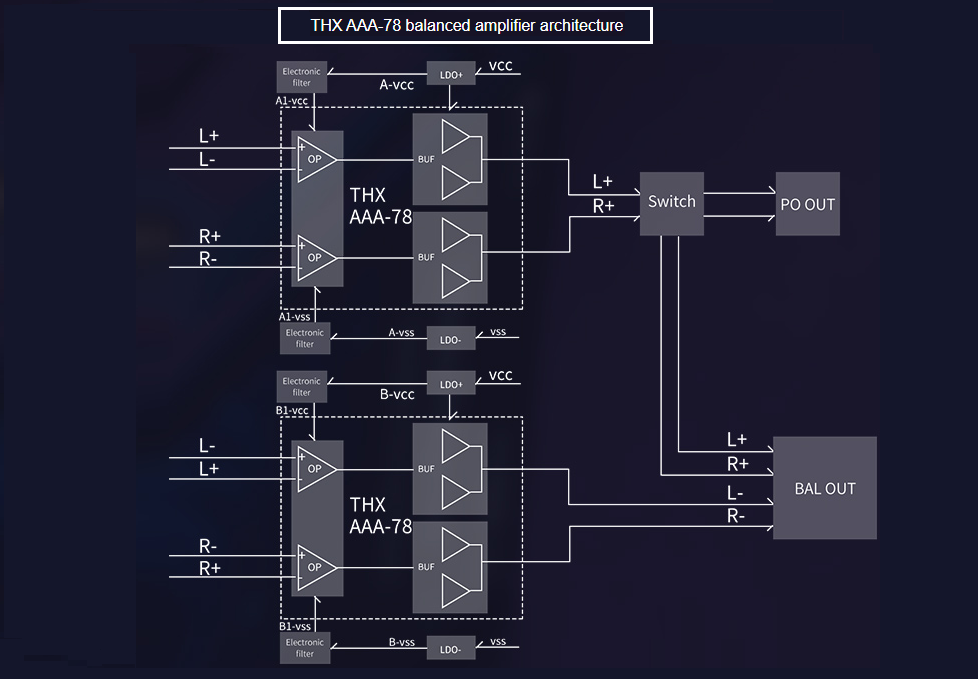
Here are some output specifications;
Line Out:
- THD+N : <0.0006%(1kHz/32Ω)
- SNR : >119dB
- Frequency response : 5Hz~86kHz(-3dB)
- Noise floor : <2μV
- Line level : 1.95V
- Channel separation : >108dB
3.5mm Headphone Out:
- THD+N : <0.00084%(1kHz/32Ω)
- SNR : ≥118dB
- Frequency response : 5Hz~86kHz(-3dB)
- Noise floor : <3μV
- Output Impedance : ≤1.1Ω
- Output Power : ≥294mW @16Ω / ≥200mW @32Ω / ≥22mW @300Ω (THD+N<1%)
- Separation : >113dB (No Load)
4.4mm & 2.5mm Balanced Out:
- THD+N : <0.00108%(1kHz/32Ω)
- SNR : ≥119dB
- Frequency response : 5Hz~86kHz(-3dB)
- Noise floor : <4μV
- Output Impedance : ≤2.4Ω
- Output Power : ≥460mW @16Ω / ≥550mW(4.2V)@32Ω / ≥88.5mW @300Ω (THD+N<1%)
- Separation : >115dB (No Load)
The recommended headphone impedance is 16~150Ω for the 3.5mm headphone output and 16~300Ω for the 2.5mm + 4.4mm balanced outputs.
Battery Life:
The FiiO M11 Pro comes with a 4370mAh 3.8V Li-polymer battery that supporting quick charge (QC2.0/MTK PE) which takes around 2 hours to fully re-charge.
The built in battery offers according to FiiO specs up to 9.5 hours of operating time over the 3.5mm headphone out (volume 63 of 120, 320kbps MP3, screen off, low gain) and approx 8.5 hours over 2.5mm+4.4mm balanced output. My test results shows around 9 hours over the 3.5mm output and approx 8 hours over the 2.5mm+4.4mm balanced output.
2. Software / GUI:
The operating system of the FiiO M11 Pro is Android OS 7.0 which is a bit outdated but efficient enough for a Digital Audio Player. The GUI (Graphical User Interface) should be very familiar to Android users and offers one of the fastest experiences on the market.

The Operating System (OS) of the FiiO M11 Pro doesn’t support Google Services like the Play Store, Play Music, etc. but comes with a FiiO alternative called Applications. The quantity of applications is limited to Music applications and services, but you can download Play Store alternatives that you can search and download (.apk files) from the Chrome Browser of the M11 Pro like APKPure, Coolapk, etc.
The FiiO M11 Pro comes also with some pre-installed applications like FiiO Music, Chrome Browser, Clock, ES File Manager and Gallery.
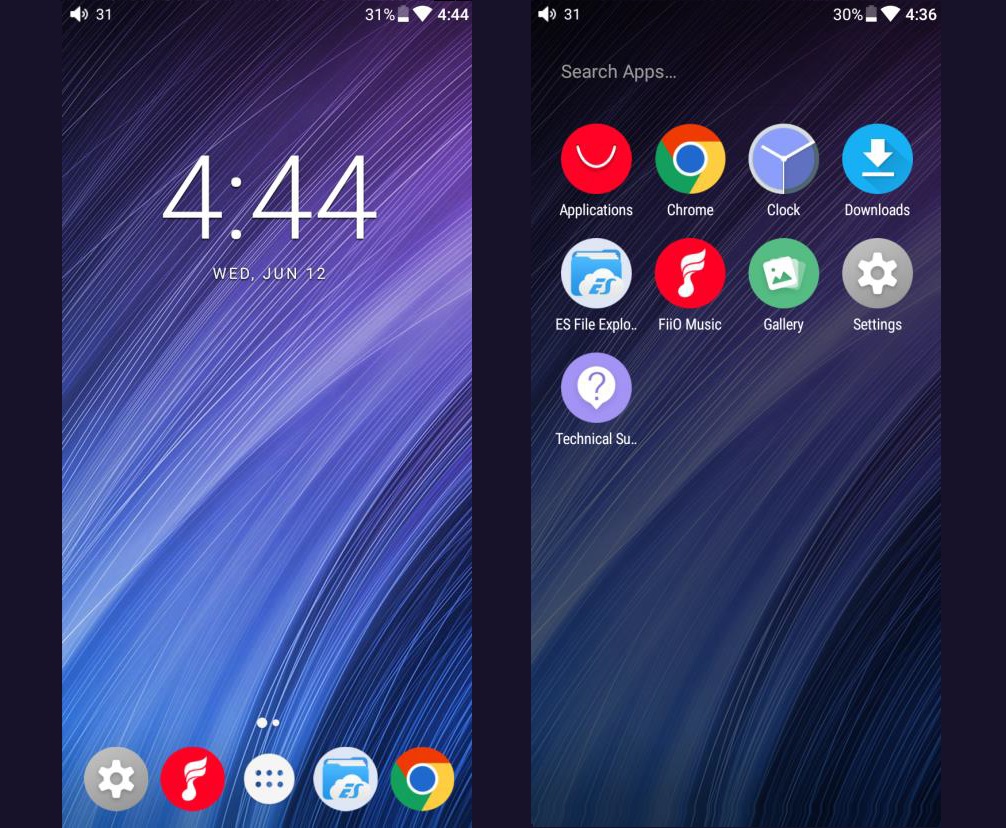
At then bottom of the home screen are the classical navigation button like the back (triangle), home (circle) and task manager (square).
The Android OS offers some nice and pretty familiar benefits like the “Top Navigation Bar” for a quick access to your Wi-Fi or Bluetooth connection. In addition there are also some helpful shortcuts like PO/LO/SPDIF out, High/Low Gain, AirPlay, Filters switcher icons.
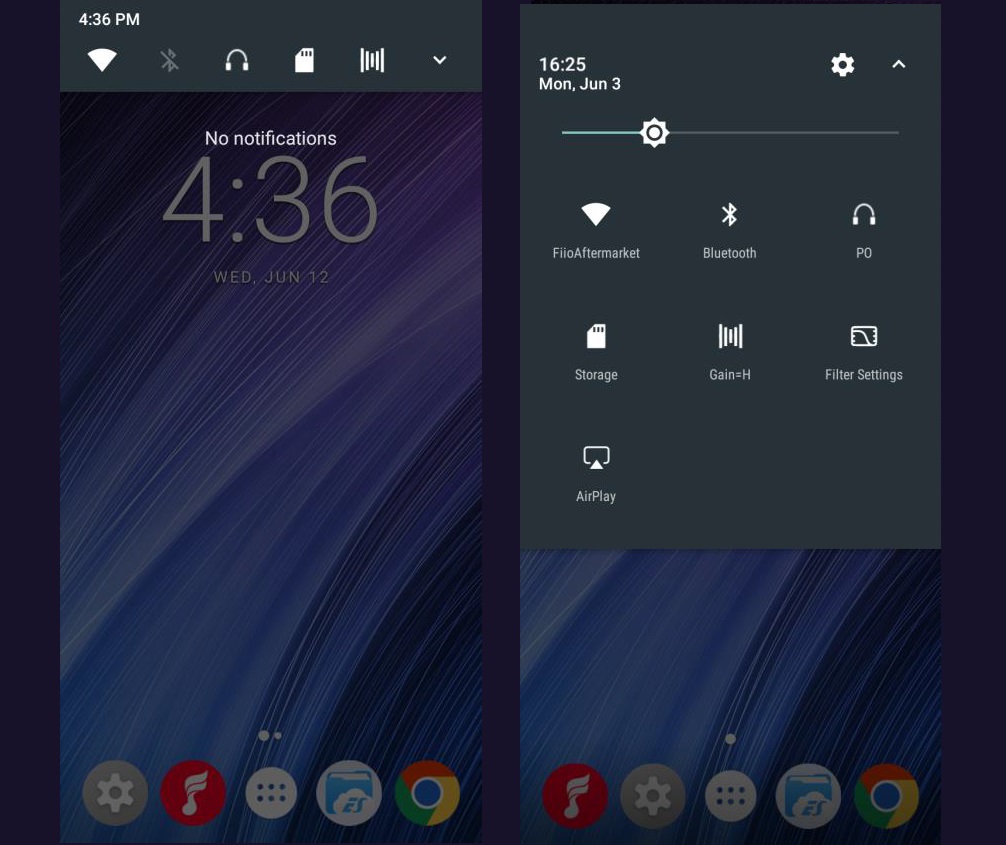
The settings menu is quite simple and many of us who are using or have used an Android device will feel very familiar with the menus and UI of the settings menu.
The Audio Settings Menu is showing some settings like Low Pass Filter Modes, Wireless Playback Quality, USB Mode (USB DAC/Storage), Low/High gain, Digital Filters, Balance, etc.

The AK4497 DAC of the M11 Pro supports 5 Digital Filters which are Sharp Roll-Off, Slow Roll-Off, Short Delay Sharp Roll-Off, Short Delay Slow Roll-Off and Super Slow Roll-Off.

The FiiO Music Player has a nice looking Graphical UI and tons of shortcuts and options under the settings menu.

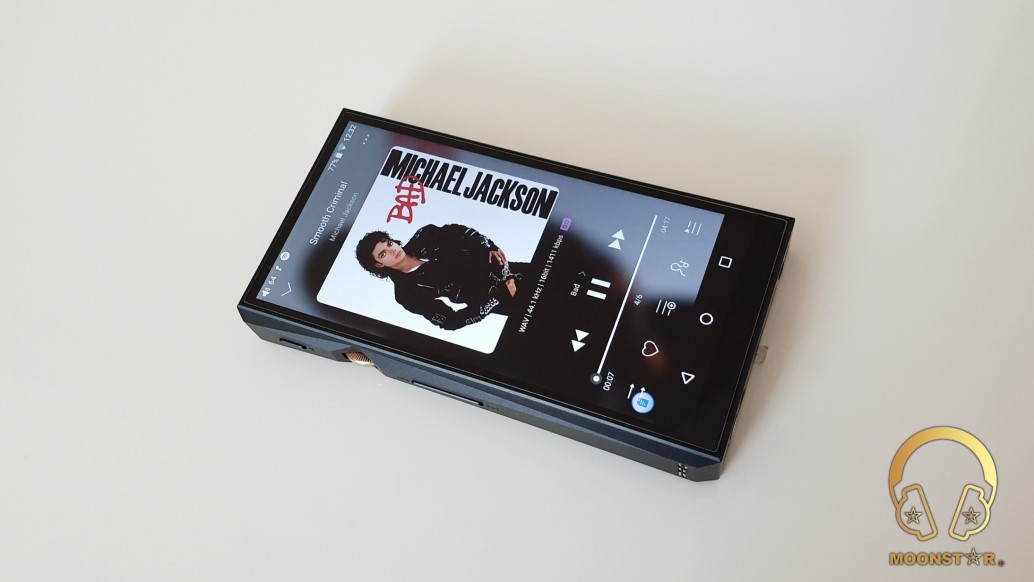


Equipment’s used for this review:
- DAP’s : FiiO M11 Pro, iBasso DX220, QLS HiFi QA361
- IEM’s : FiiO FH7, FiiO FA7, FiiO FH5, Final Audio B3
- Earbuds : Rose Masya Pro, Simphonio SilverDragon2+
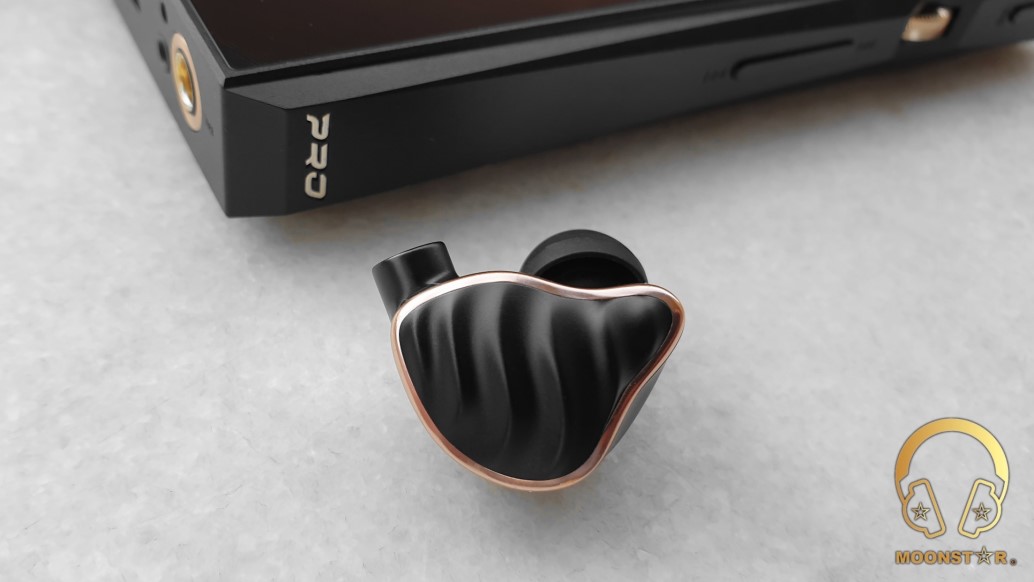
Albums & tracks used for this review:
- Gogo Penguin – Raven (Flac 24bit/192kHz)
- Photek – Hidden Camera (Flac 16bit/44.1kHz)
- Otto Liebert& Luna Negra – The River (DSF) – Binaural Recording
- Vivaldi – Le QuarttroStagioni “The Four Season” (Wav 24bit/88kHz)
- Chopin – Nocturn No. 20 In C-Sharp Minor (Flac 16bit/44.1kHz)
- Armin Van Buuren – Vini Vici (Spotify)
- Lorde – Royal (Flac 24bit/48kHz)
- Tom Player – Resonace Theory (16bit/44.1kHz)
- Massive Attack – Angel (Flac 24bit/192kHz)
- Portishead – The Hidden Camera (Flac 16bit/44.1kHz)
- Twerl – Lishu (Flac 16bit/44.1kHz)
- Opeth – Windowpane (Wav 16bit/44kHz)
- Metallica – Sad but True (Flac 24bit/96kHz)
- Megadeth – Sweating Bullets (Flac 24bit/96kHz)
- Rush’s – Leave That Thing Alone (Flac 16bit/44.1kHz)
- Slayer – Angel of Death (Flac 24bit/96kHz)
- Michael Jackson – Billie Jean (Flac 24bit/192kHz)
- Elton John – Your Song (Flac 24bit/192kHz)
- David Bowie – Black Star (Flac 24bit/96kHz)
- Dave Gahan – Kingdom (Flac 16bit/44.1kHz)
- Eric Clapton – Unplugged Album (Flac 24bit/96kHz)
- B.B. King – Riding With The King (Flac 24bit/96kHz)
- No Doubt – Hella Gut (Flac 16bit/44.1kHz)
- First Aid Kit – My Silver Lining (Flac 16bit/44.1kHz)
- London Grammar – Interlude (Live) (Flac 24bit/88kHz)
- Aretha Franklin – I Say a Little Prayer (Wav 16bit/44.1kHz)
- Diana Krall – So Wonderful (DSF)
The Sound:
The FiiO M11 Pro has a close to neutral, mildly warmish and slightly bright tonality with good bass speed and depth, great level of midrange detail retrieval & clarity, along with a strong and well extending treble presentation. The M11 Pro is the most technical, balanced and detailed sounding Digital Audio Player of the M series.
Here are the main/noticeable differences between the 4.4mm/2.5mm Balanced Output and 3.5mm Single Ended Output;
The Balanced outputs of the FiiO M11 Pro have a stronger output power and darker background than the 3.5mm. In particular, the bass output of the balanced outputs is deeper than the 3.5mm and the bass character is in general tighter in its presentation. The soundstage of the balanced outputs is both larger and deeper than those of the 3.5mm unbalanced out, while the midrange presentation of the 3.5mm sounds a bit more recessed than the balanced outputs that do sound more intimate.
PS: This review is based on the 4.4mm (TRRRS) & 2.5mm (TRRS) Balanced Output which is superior in terms of sound quality/performance compared to the 3.5mm TRS output of the FiiO M11 Pro.

The Bass:
The FiiO M11 Pro is a very good device in terms of reproduction/rendering of deep bass notes and doesn’t add additional bass to the sound if its not exists in the song. The M11 Pro can be described as a DAP that has a close to reference presentation in the bass region.
The FiiO M11 Pro has in general a subbass presentation that is accented and that shows a good level of depth. The tonality is slightly warmish, while it is also pretty controlled. The subbass extension and overall quantity/rumble is above average without to have negative side effects like muddiness. The M11 Pro shows a god subbass intensity, depth and extension in songs like Lorde’s “Royals”, Photek’s “The Hidden Camera” and Twerl’s “Lishu”.
The midbass area of the FiiO M11 Pro is as effective as the subbass, with its good level of impact and slam effect. The M11 Pro is a DAP that doesn’t hesitates to produce hard hitting midbass impacts if it’s available in the recording. It is also quite compatible with bass-heavy IEM’s because it doesn’t cause to negative situations such as midbass humps. The midbass area is highly controlled and has a sufficient amount of for almost any type of genre. It is successful from electronic music recordings up to the drums in metal music.
Instruments like drums in intros like Michael Jackson’s “Billie Jean”, No Doubt’s “Hella Gut” or Opeth’s “Windowpane” are fast, pronounced detailed and full bodied.
The Fiio M11 Pro is a DAP that stands out with its technical bass as well as its fun factor. Technically, the basses have good speed, separation, tightness, emphasis and resolution. That’s why the M11 Pro doesn’t lack much in the bass department. The bass are quantitatively above one step of the analytical type of bass and one step bellow the of bass-head level of bass.
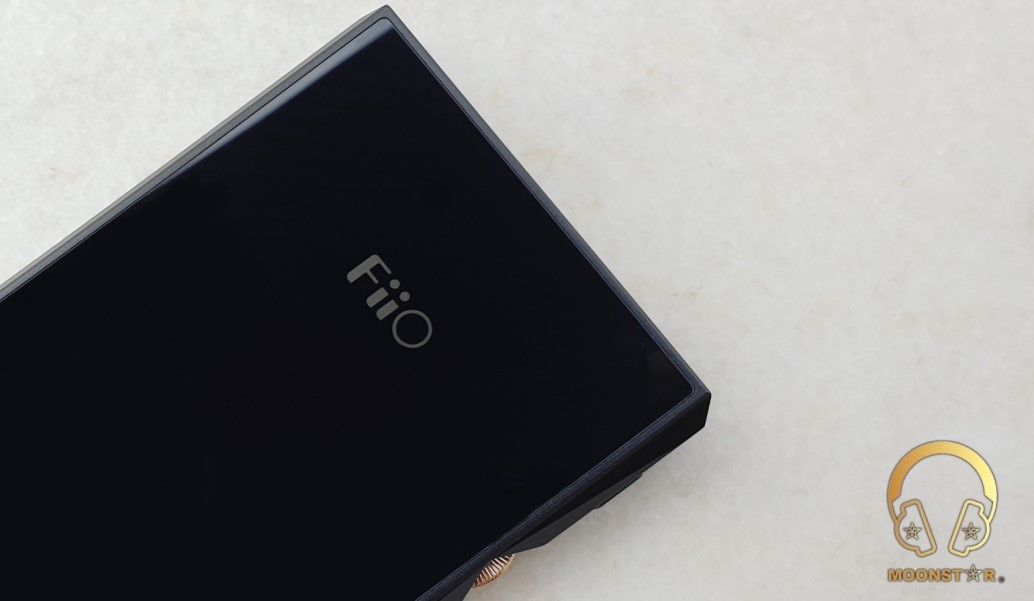
The Midrange:
The overall midrange tonality of the FiiO M11 Pro is slightly warm, close to neutral, clear and highly transparent with good levels of transparency, spaciousness and detail retrieval.
Vocals:
The FiiO M11 Pro is very successful in terms of emphasis, extension, detail and transparency of female vocals due to its strong upper midrange response. One of the positive abilities of the FiiO M11 Pro is that vocals are quite transparent but doesn’t show too much glare. It is a pleasure to listen female voices with the M11 Pro, form mezzo-soprano to soprano female vocals, while the transitions of ups and downs are very smooth and controlled. I didn’t face any noteworthy negative situations like sibilance or harshness.
The FiiO M11 Pro offers a clean and detailed vocal presentation and didn’t hear any issues like muddiness or mixings. The lower midrange is not as pronounced like the upper midrange of female vocals and shows an average depth and fullness. But don’t get me wrong; vocals form Dave Gahan to Leonard Cohen, from Eric Clapton to Michael Jackson is pretty pleasant to listen to.
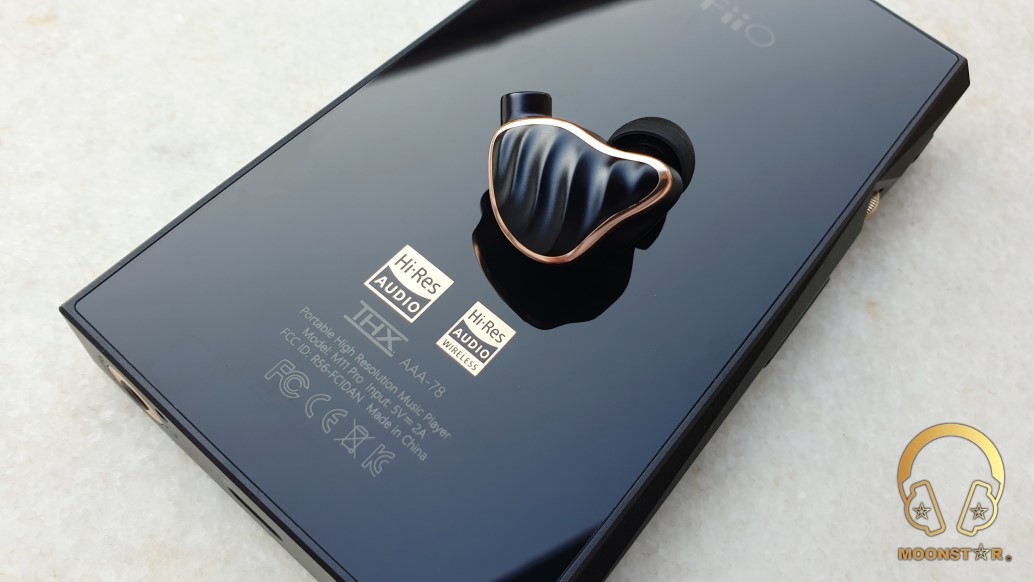
Instruments:
The FiiO M11 Pro has a lightly bright, fairly neutral and clear instrument tonality with a detailed and airy. The M11 pro is quite successful in terms of instruments separation and distinction. Instruments like the pianos are slightly bright and pronounced, while acoustic guitars are natural, transparent and fast. Other instruments like violins are a bit bright but not too sharp, while violas are successful represented with exception of a slightly lack of warmth.
The M11 Pro has a quite accurate instrument and vocal layout with an instrument and vocal separation that shows an above average performance for this price range.
Upper Midrange:
The FiiO M11 Pro has a strong upper midrange emphasis with a transparent and neutral tonality.
The M11 Pro shows a good performance in terms of detail and control in moments when instruments play with high level of distortion. For example, instruments in metal music like cymbals and drums are very clear. It is rarely to find a DAP at this price range that shows such a level of clarity during higher distortions. Guitars and guitar solos played with high distortion in Megadeth’s “Sweating Bullets”, Slayer’s “Angel of Death” or Rush’s “Leave That Thing Alone” are clear and detailed. Instruments like pianos on the other hand are bright, detailed and do show a good level of extension.

The Treble:
The FiiO M11 Pro has an airy, soft, neutral and fairly pretty bright treble presentation that doesn’t bother and that is fatigue-free. The treble performance of the M11 Pro in terms of intensity, extension, sharpness and airiness is above average. Both the performance of the lower treble (presence) and the upper treble (brilliance) extension are on a very good level. The additional emphasis of the upper treble is unlikely to be the case for most DAP’s.
a) Extension:
The M11 Pro is a pretty good device in terms of treble extension and doesn’t show any early roll-off in this frequency region. Instruments like hi-hats, crash and ride cymbals have a good extension.
b) Intensity:
The intensity of the treble is very strong and is the tonality especially at moments with greater treble sharpness is breathtaking.
c) Sharpness:
The treble sharpness of the FiiO M11 Pro can be positioned at an above-average level for a device at this price range. For example drumstick hits do come down from a single point and are pretty sharp in tonality which is a great ability especially for genres like jazz or metal music.
d) Clarity and Refinement:
Instruments like cymbals in genres like jazz, classic and metal music do sound quite clear and I was able to hear small micro details. The FiiO M11 Pro has a very fast treble presentation. Even the most complex and fast cymbal passages are no issue for it.
The FiiO M11 Pro has in general a very transparent, airy and spacious treble presentation, which makes it to an ideal DAP for many genres.

The Soundstage:
The soundstage of the FiiO M11 Pro shows a good performance in terms of width and depth which are quite parallel in size to each other. The general presentation is airy and spacious which makes the M11 Pro compatible with genres with lots of instruments that require a wide and deep area and good level of separation.
Some Short Comparisons:
FiiO M11 Pro versus iBasso DX220:
The FiiO M11 Pro has a closer to neutral presentation compared to the iBasso DX220 which do sound a bit warmer and fuller. The DX220 has the upper hand in terms of subbass depth and extension and shows slightly more intensity. Both devices are successful in terms of midbass speed, control and emphasis, while the M11 Pro has the slightly edge in this regarding.
The FiiO m11 pro has a slightly warm, transparent and detailed midrange presentation. The iBasso DX220 on the other hand has a slightly softer and warmer midrange with a good level of transparency. The lower midrange of the DX220 shows a bit more depth and fullness which gives it the upper hand for male vocals. The FiiO M11 Pro on the other hand shows a more pronounced upper midrange that adds better level of extension and clarity to female vocals.
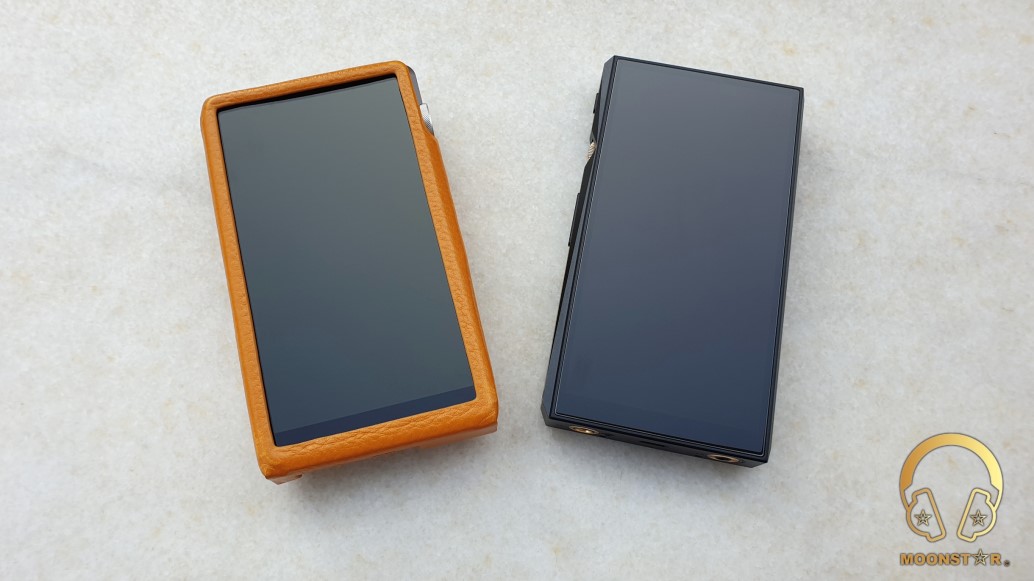
The upper midrange of the M11 Pro is sharper than those of the DX220 which has a softer and slightly more controlled presentation. Fast and complex tracks do sound more controlled with the DX220.
Both devices are very successful in terms treble extension and airiness. The FiiO M11 Pro is superior to the DX220 in terms of treble quantity and extension. Both the DX220 and M11 Pro are great devices in terms of soundstage performance. The main difference is that the FiiO M11 Pro has the upper hand in terms of soundstage width, while the iBasso DX200 has the slightly edge for the depth.
The M11 Pro sounds slightly more airy.
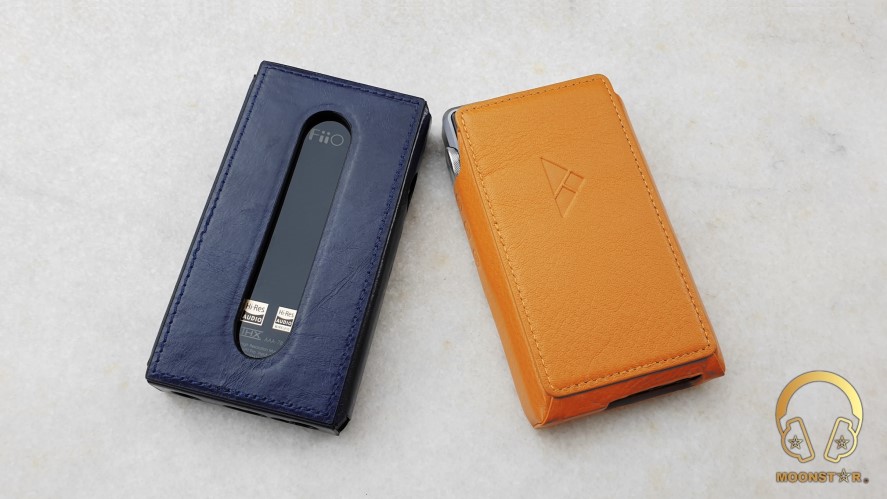
FiiO M11 Pro versus QLS QA361:
The QLS QA361 is a fairly neutral and soft sounding Digital Audio Player, while the FiiO M11 Pro shows a slightly warmer tonality.
Both devices do have a good quality subbass presentation with sufficient depth and soft tonality. The FiiO M11 Pro has the upper hand in terms of depth, quantity and extension. The QLS QA361 has in general a more linear bass character. The M11 Pro has a strong, punchy and slightly warm midbass tuning, while the QA361 has a more neutral midbass presentation with an average impact and intensity. The M11 Pro is superior to the QA361 in terms of midbass impact and intensity. The QA361 seems to be slightly better in terms of bass decay and speed.

The QLS QA361 and FiiO M11 Pro have a slightly soft, close to neutral and transparent/clear midrange presentation. The midrange of both devices is detailed and shows a pretty similar sound signature. The lower midrange of the M11 Pro sounds fuller/thicker and is deeper in its presentation, which makes it more successful with male vocals. The upper midrange on the other hand is pronounced on both devices, while the QA361 has a slightly softer and the M11 Pro a bit sharper tonality. The clarity and detail level of female vocal of both devices is above average.
The treble range of the QLS QA361 is smooth, close to neutral and pretty controlled, while the FiiO M11 Pro has a more pronounced treble range with better extension. The soundstage of the QA361 is better in terms of wideness, while the M11 Pro has a slightly more depth.

Conclusion:
FiiO created with the M11 Pro an innovative Digital Audio Player with a detail oriented sound which shows a good synergy with a wide variety of earphones and music genres. In addition to the very good build quality, offers the M11 Pro numerous hardware and software futures, like the AK4497EQ DAC chip, a big IPS display with a nice screen to body ratio, lots of wired & wireless connectivity options, a stabile and fluid UI and many more that makes it to a device with a great value for the money.
Pros and Cons:
- + Overall Clarity & Detail Retrieval
- + Treble Resolution & Extension
- + Bass Speed and & Control
- + Very Clean/Black Background over the 4.4mm/2.5mm Balanced Outputs
- + Fluid UI, Good Build Quality, Great Screen to Body Ratio
- + Lots of Wired & Wireless Connectivity Options
- – No Protective Case Included to the Standard Package
- – Only One Micro SD card slot (M11 has Two Slots)
- – No Google Pay services (can be partially solved with third-party apps)

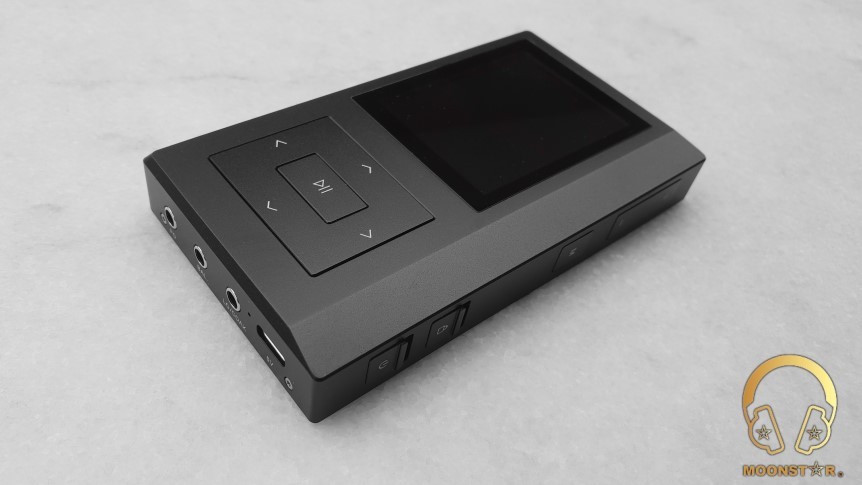
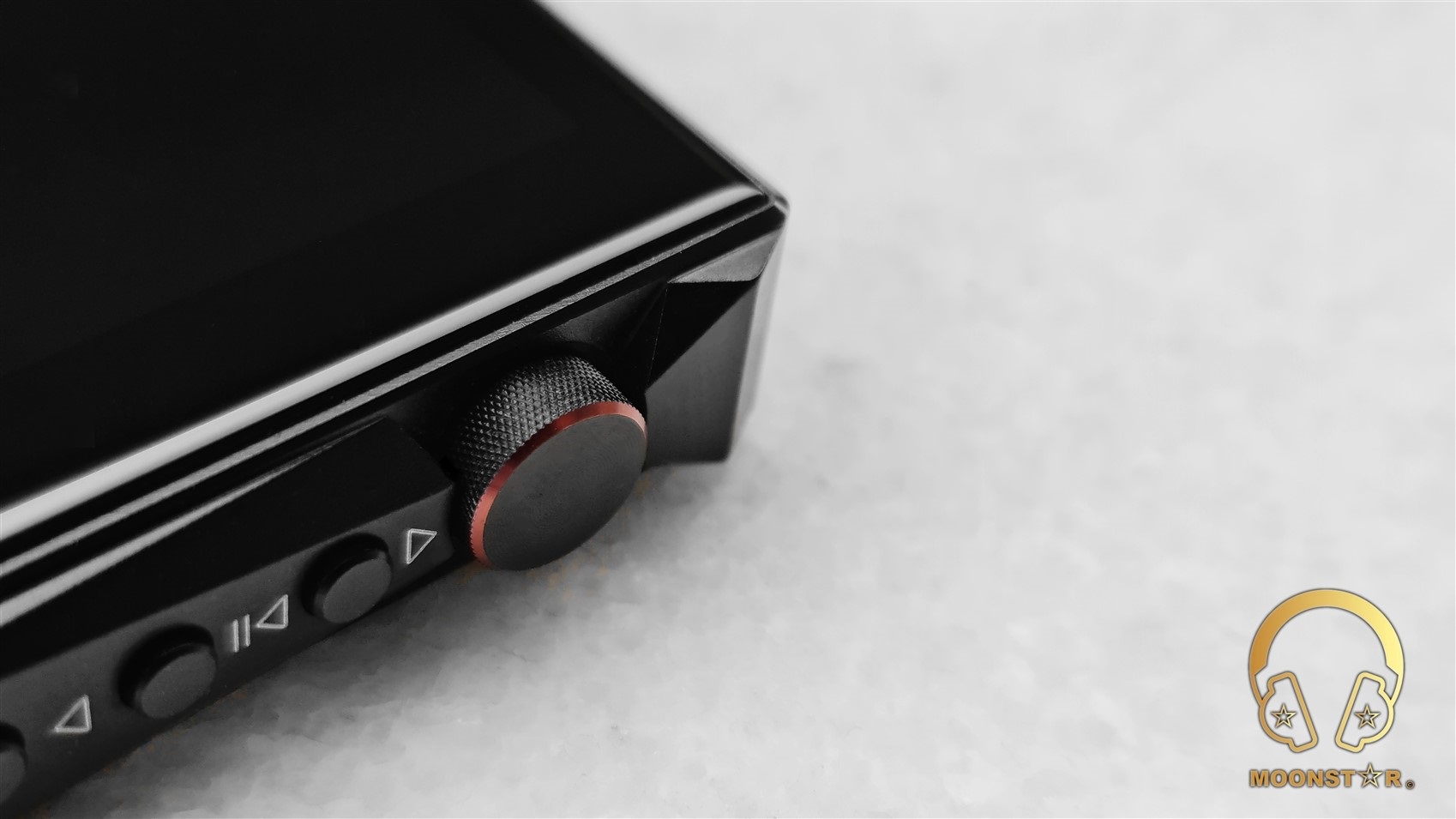









Wm1a ile bir kıyaslama yapabilirmisiniz